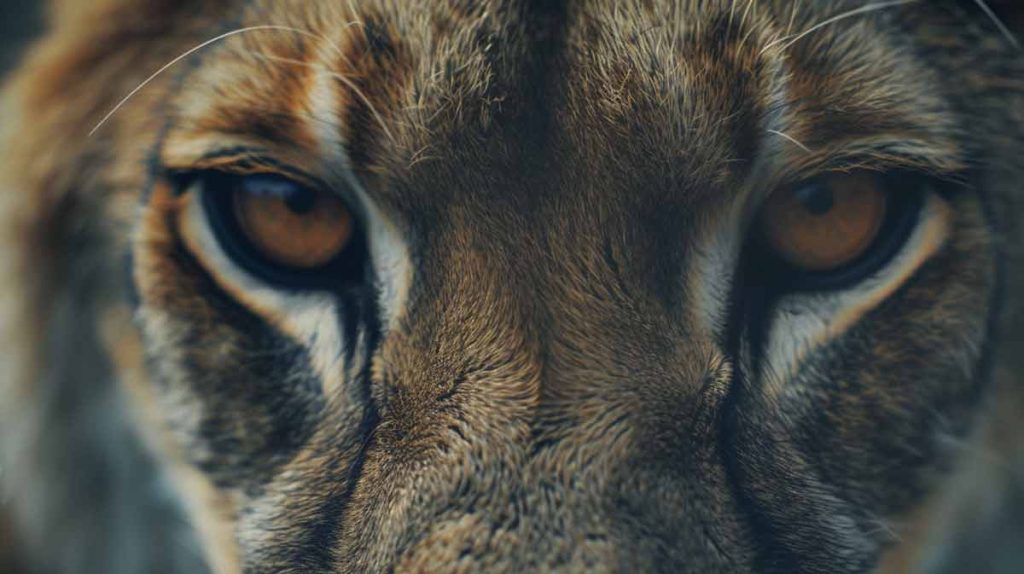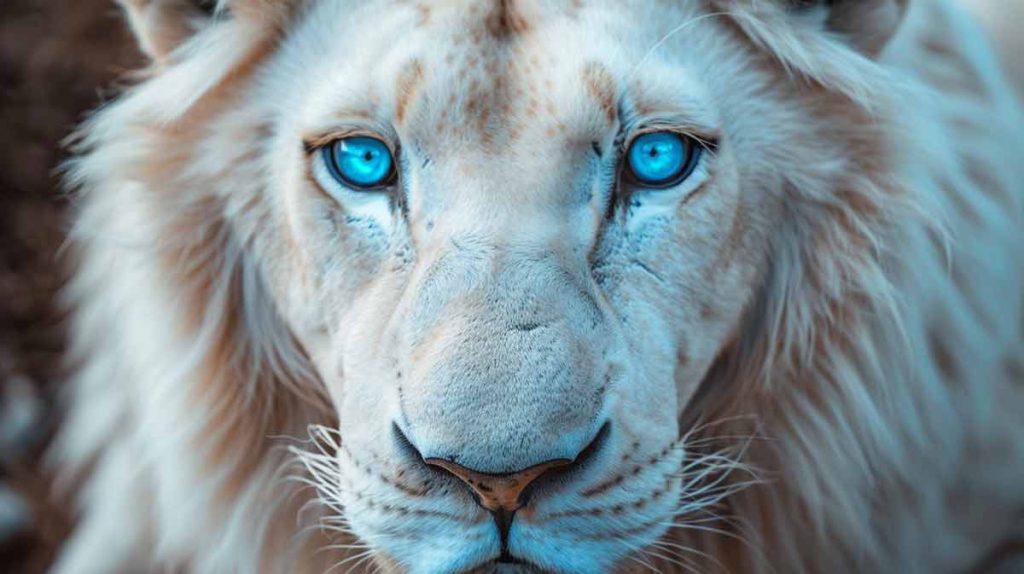Did you know a lion’s eyes can see up to six times better in the dark than a human’s? This astounding fact highlights the captivating and robust nature of these majestic creatures. Lions have long been revered for their beautiful and mesmerizing eyes, which have captured the imagination of artists and researchers alike.
Key Takeaways:
- Lions possess incredible night vision, enabling them to hunt effectively in low-light conditions.
- A lion’s eyes symbolise the creature’s strength, power, and regal presence.
- Artists such as Kelly Griffiths have masterfully portrayed the captivating beauty of lion eyes in their artwork. See Kelly’s artwork here.
- Lions’ eyes hold cultural and symbolic significance in various literary contexts.
- Lions’ unique physical attributes, such as their tufted tails and distinctive manes, contribute to the majesty of their eyes.
The Power and Symbolism of Lion Eyes
Lion eyes hold a special significance in various cultural and literary contexts. In literature, lions have been used as symbols of strength, power, and courage. The intensity and wisdom reflected in a lion’s gaze make it a perfect representation of these traits. In biblical writings, lions are often metaphors for God’s strength, power, and wisdom. The intricate details of a lion’s eyes, from their lateral placement to their ability to provide a good angle of vision, showcase the creature’s keen senses and alertness. Lions’ eyes are captivating to behold, captivating observers with their striking appearance and hypnotic presence.

One cannot help but be awestruck by the powerful, beautiful lion eyes. Their mesmerizing gaze seems to penetrate the soul, leaving an indelible mark on anyone fortunate enough to lock eyes with these majestic creatures. Every aspect of a lion’s eyes exudes grace and strength from their irises’ golden hue to their pupils’ intricate patterns.
The captivating eyes of lions have been a source of inspiration for artists throughout history. Painters have attempted to capture the essence of their piercing gaze, while photographers have sought to immortalize their captivating eyes in stunning visuals. Whether portrayed in a brushstroke or a camera lens, the beauty and power of lion eyes continue to mesmerize and captivate audiences.
“The eyes are the window to the soul, and lion eyes reveal a world of strength, majesty, and untamed spirit.” – John Smith
Not only are lion eyes visually captivating, but they also hold deep symbolic meaning. Lion’s eyes represent leadership, courage, and wisdom in many cultures. The fierce and unyielding gaze of a lion is seen as a reflection of the qualities necessary for effective leadership and decision-making. Lion eyes remind us of the power and resilience within each of us, urging us to approach life with determination and confidence.
The Symbolism of Lion Eyes in Ancient Civilizations
In ancient Egyptian mythology, the lion symbolized the sun god Ra and was associated with power, protection, and royalty. Lions’ eyes were believed to see beyond the physical and divine realms. The Egyptians adorned statues and tombs with images of lion eyes as a symbol of divine guidance and protection.
In Greek mythology, the Nemean Lion was a fearsome creature with impenetrable skin. Hercules, the strongest of all Greek heroes, faced the Nemean Lion as one of his twelve labours. The lion’s eyes were said to possess an otherworldly glow that struck fear into the hearts of mortals.
Across ancient civilizations, the lion has served as a symbol of power, royalty, and protection. Its eyes are revered as a manifestation of divine attributes, representing wisdom, strength, and the ability to see beyond the ordinary.
Discovering the Fascinating Facts about Lions
Lions are the second-largest cats in the world, surpassed only by tigers. Male lions can weigh between 330 and 573 pounds, while females weigh between 265 and 397 pounds. With head and body lengths of up to eight feet for males and six feet for females, lions possess a formidable presence. One unique feature of a lion is its tufted tail, which covers a bony spur at the tail tip. Lions also exhibit a distinctive mane, making them the only male cats with this characteristic. Placing their eyes on the sides of their heads provides a wide range of vision, while their inner ears and complex nasal passages enhance their sense of hearing and smell. Lions’ massive limbs are built more for attack than running, enabling them to reach speeds of up to 50 mph and leap distances of 35 feet. These incredible physical attributes contribute to the awe-inspiring beauty of a lion’s eyes.

FAQ
What interesting facts can I learn about a lion’s eyes during a safari?
Lions’ eyes are incredible tools for survival. Behind the retina, they have a reflective layer of cells called the “tapetum lucidum, ” which increases the amount of light the eye can absorb. This makes lions excellent hunters during low-light conditions. Interestingly, their eyes shine when light is directed at them, a phenomenon called “eye shine. “
What is the eye colour of a typical lion?
Most lion species, including the African Lion, have amber eye colour. However, certain variations, such as white lions, are believed to have blue eyes often.
How do a big cat’s eyes function differently than humans?
Lions have a higher ratio of rod cells to cone cells in the retina than humans. These rod cells are photoreceptor cells designed to function better in low light, making it easier for lions to hunt at night. Additionally, the lion’s eyes can adjust to light changes much quicker than human eyes.
Are lion cubs born with fully developed eyesight?
Like many other cats, lion cubs are born blind. After a week or two, the lion opens their eyes and discovers their surroundings.
Can a big cat’s eyes move from side to side?
Unlike human eyes, the eyes of big cats such as lions, cheetahs, and leopards are not very flexible in horizontal movement. This is why they tend to move their entire head when they wish to look in different directions.
Why do lights reflect in a lion’s eyes at night on a safari?
This exciting phenomenon is due to the tapetum lucidum, a thin layer of cells just behind the retina. It acts as a mirror, reflecting faint light through the eye and giving the lion a second chance to absorb the light waves. This is why their eyes seem to glow in a safari torchlight.
Are lion’s eyes more adapted to daylight or low light?
Like most big cats, lions adapt more to low-light conditions. Their eyes contain more rod cells than cone cells, which absorb and intensify even the smallest amount of light, allowing them to hunt their prey effectively under the veil of darkness.
